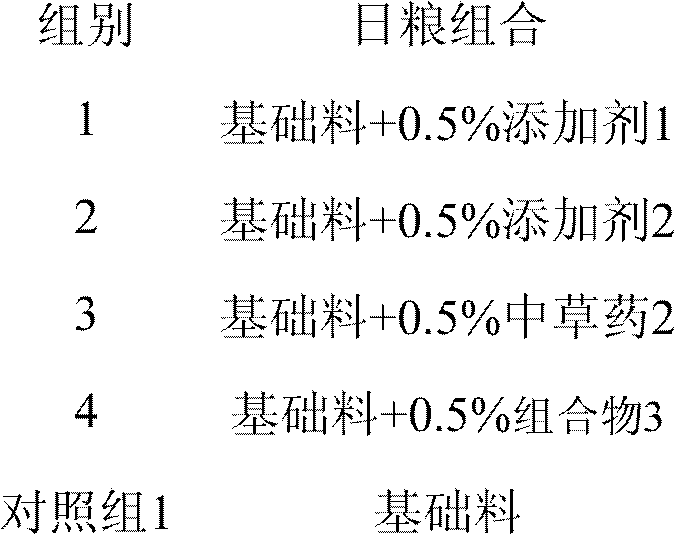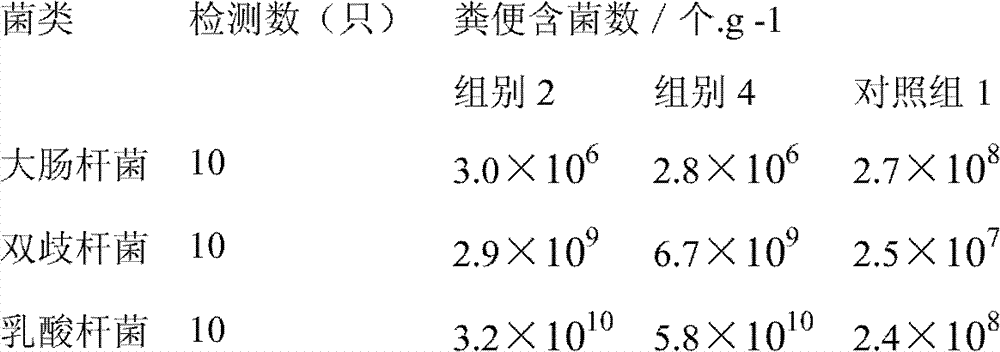Micro-ecological synbiotic Chinese herbal medicine feed addictive, preparation method and application thereof
A technology of Chinese herbal medicine additives and feed additives, applied in animal feed, animal feed, application and other directions, can solve the problems of Bacillus subtilis not producing lactic acid, lactobacillus not being heat-resistant, etc. Cost, effect of promoting pancreatic secretion
- Summary
- Abstract
- Description
- Claims
- Application Information
AI Technical Summary
Problems solved by technology
Method used
Image
Examples
Embodiment 1
[0030] The preparation of embodiment 1 microecological synbiotics feed additive
[0031] 1. Weigh the oligosaccharides as fructo-oligosaccharides, xylo-oligosaccharides, isomalto-oligosaccharides and soybean oligosaccharides each 10Kg for later use;
[0032] Two, the preparation of lactic acid bacillus preparation:
[0033] Bacterial kind is lactic acid bacillus (lactic acid bacillus) preserved by freeze-drying; The lactic acid bacillus culture medium I calculates and is made up of the following components in parts by weight: 0.5 part of peptone, 0.3 part of beef extract, 0.1 part of yeast extract, 0.5 part of sodium chloride parts, MnSO 4 part.H 2 O 0.005 parts, CaCl 2 0.00756 parts, MgSO 4 .7H 2 0.05 parts of O, 99 parts of ultrapure water, pH 6.8, sterilized by high-pressure steam at 115°C for 30 minutes;
[0034] ① Expand the seed fungus, take the fungus on the inclined surface (such as an inoculation loop) and inoculate it into a test tube containing Lactobacillus ...
Embodiment 2
[0049] The feeding effect of embodiment 2 ducklings
[0050] Cherry Valley meat ducks were selected for the test ducklings. At the beginning of the test, 240 healthy chicks hatched at the same age were selected for centralized brooding. After one week of age, they were randomly divided into 4 groups of 60 ducks in each group. Individual body weight, after the homogeneity P>0.05 among each group was determined by variance analysis, the 4 groups of test ducks were randomly determined as 4 different treatment groups to feed the test duck feed, and the test period was 44 days. The diet combinations of each group are shown in Table 1.
[0051] Table 1 Experimental grouping and diet combination
[0052]
[0053] Described base material is the conventional gosling feed of market sale, and above-mentioned percentage is percentage by weight
[0054] Table 2 Effects of different combinations and dosages on the performance of ducklings (g)
[0055]
[0056] It can be seen from T...
Embodiment 3
[0060] The feeding effect of embodiment 3 piglets
[0061] Weaned piglets of the same parity with normal growth and development and relatively consistent body weight were selected. The test pigs were randomly divided into 5 groups according to body weight and gender, with 21 piglets in each group, 3 replicates in each group, 7 piglets in each replicate, and no significant difference between groups (P>0.05). . The test period is 30 days, and the pre-trial period is 2 days. The diet combinations of each group are shown in Table 4.
[0062] Table 4 Experimental grouping and diet combination
[0063]
[0064]
[0065] Described basic material is the routine piglet feed of market sale; Above-mentioned percentage is percentage by weight
[0066] Table 5 Effects of different combinations and dosages on piglet performance (g)
[0067]
[0068] Note: The data adopts the mean ± standard deviation; the numbers on the same row are marked on the shoulder * and ** Indicates ...
PUM
 Login to View More
Login to View More Abstract
Description
Claims
Application Information
 Login to View More
Login to View More - R&D Engineer
- R&D Manager
- IP Professional
- Industry Leading Data Capabilities
- Powerful AI technology
- Patent DNA Extraction
Browse by: Latest US Patents, China's latest patents, Technical Efficacy Thesaurus, Application Domain, Technology Topic, Popular Technical Reports.
© 2024 PatSnap. All rights reserved.Legal|Privacy policy|Modern Slavery Act Transparency Statement|Sitemap|About US| Contact US: help@patsnap.com










